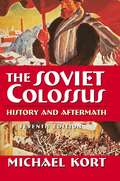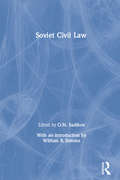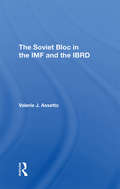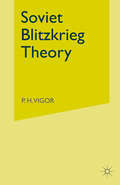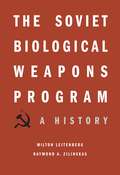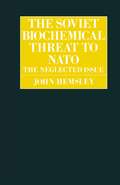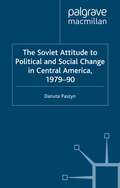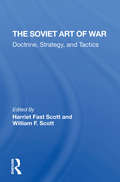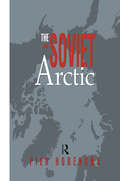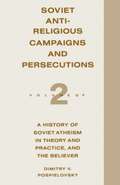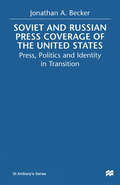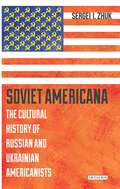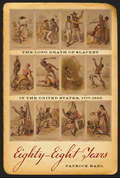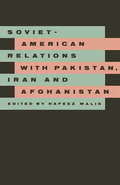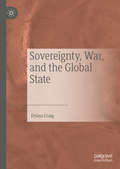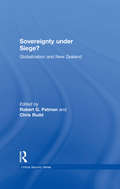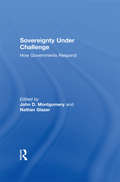- Table View
- List View
The Soviet Colossus: History and Aftermath
by Michael KortThe twentieth century was not kind to Russia. Despite its great potential and remarkable achievements, the country also bore the weight of two world wars, a revolution and civil war, totalitarian tyranny, famine and ecological destruction, economic ruin, and imperial decline. Will Russia ever be prosperous, peaceful, and free? Seeking clues in the past, Michael Kort revisits earlier turning points in Russia's history--from the fall of the old regime to the establishment of the Bolshevik dictatorship and Stalinist totalitarianism; from the reforms and counter-reforms of Khrushchev and Brezhnev to the tumultuous years of change under Gorbachev and Yeltsin. Which strands of Russia's past is their successor, Vladimir Putin, weaving into the fabric of the present, and which are being allowed to fade, for better or worse? This new edition of The Soviet Colossus brings the story up through the first decade of the twenty-first century. Distinctively readable, judicious, and focused on critical events and questions, it integrates new revelations about the Soviet past and ongoing debates about the Soviet regime as well as its successor. It is the ideal text for as one semester history course or background for a political science course.
The Soviet Colossus: History and Aftermath
by Michael KortThe twentieth century was not kind to Russia. Despite its great potential and remarkable achievements, the country also bore the weight of two world wars, a revolution and civil war, totalitarian tyranny, famine and ecological destruction, economic ruin, and imperial decline. Will Russia ever be prosperous, peaceful, and free? Seeking clues in the past, Michael Kort revisits earlier turning points in Russia's history--from the fall of the old regime to the establishment of the Bolshevik dictatorship and Stalinist totalitarianism; from the reforms and counter-reforms of Khrushchev and Brezhnev to the tumultuous years of change under Gorbachev and Yeltsin. Which strands of Russia's past is their successor, Vladimir Putin, weaving into the fabric of the present, and which are being allowed to fade, for better or worse? This new edition of The Soviet Colossus brings the story up through the first decade of the twenty-first century. Distinctively readable, judicious, and focused on critical events and questions, it integrates new revelations about the Soviet past and ongoing debates about the Soviet regime as well as its successor. It is the ideal text for as one semester history course or background for a political science course.
Soviet Civil Law
by O.N. SadikovThis volume is an unabridged translation of the textbook ‘Soviet Civil Law’, originally published in 1983 under the auspices of the USSR Ministry of Justice. Edited by Professor O.N. Sadikov, the work includes contributions from nine Soviet legal scholars
Soviet Civil Law
by O.N. SadikovThis volume is an unabridged translation of the textbook ‘Soviet Civil Law’, originally published in 1983 under the auspices of the USSR Ministry of Justice. Edited by Professor O.N. Sadikov, the work includes contributions from nine Soviet legal scholars
The Soviet Bloc In The Imf And The Ibrd
by Valerie J AssettoIn this book, the author surveys performance of the Soviet Bloc states in the International Monetary Fund (IMF) and the International Bank for Reconstruction and Development (IBRD) for evidence of unusual levels of assistance using aggregate data obtained from IMF and IBRD sources.
The Soviet Bloc In The Imf And The Ibrd
by Valerie J AssettoIn this book, the author surveys performance of the Soviet Bloc states in the International Monetary Fund (IMF) and the International Bank for Reconstruction and Development (IBRD) for evidence of unusual levels of assistance using aggregate data obtained from IMF and IBRD sources.
The Soviet Biological Weapons Program: A History
by Milton Leitenberg Raymond A Zilinskas Jens H KuhnThis is the first attempt to understand the full scope of the USSR’s offensive biological weapons research, from inception in the 1920s. Gorbachev tried to end the program, but the U.S. and U.K. never obtained clear evidence that he succeeded, raising the question whether the means for waging biological warfare could be present in Russia today.
The Soviet Biological Weapons Program: A History
by Milton Leitenberg Raymond A Zilinskas Jens H KuhnThis is the first attempt to understand the full scope of the USSR’s offensive biological weapons research, from inception in the 1920s. Gorbachev tried to end the program, but the U.S. and U.K. never obtained clear evidence that he succeeded, raising the question whether the means for waging biological warfare could be present in Russia today.
The Soviet Attitude to Political and Social Change in Central America, 1979–90: Case-Studies on Nicaragua, El Salvador and Guatemala (Studies in Russia and East Europe)
by D. PaszynThe study analyses Soviet policy towards Nicaragua during the rule of the Sandinista National Liberation Front (FSLN) and towards the guerrillas fighting for political and social change in El Salvador and Guatemala. It covers the period from the Sandinista victory in July 1979 until the loss of power in February 1990. This work aims to counter the tendency found in the western literature which over-emphasizes the ideological and strategic factors motivating Soviet policy towards Nicaragua and Central America as a whole.
The Soviet Art Of War: Doctrine, Strategy, And Tactics
by Harriet Fast Scott William F. ScottNo other nation has invested as much intellectual capital in the study of war as has the Soviet Union over the last six decades, and the doctrine, strategy, and tactics that have been developed by Soviet theoreticians are bound to guide any future Soviet military action. The Soviet Art of War makes available to Western readers selections from the most significant and influential Soviet military writings from 1917 to the present. The Scotts have examined thousands of Soviet military publications, including the restricted journal of the Soviet General Staff, Voyennaya Mysl', to make this book the most comprehensive account of Soviet military theory and practice yet published. The papers they have chosen thoroughly illustrate the development of the basic features of Soviet military art, from the days of trench warfare to the era of the nuclear battlefield. These documents demonstrate the emphasis on surprise, on deception, on mass deep penetration of enemy defenses, and on a unified strategy for all services. They also show the forms of military action—destruction and attrition, defense and offense, maneuver and position-as seen through the eyes of leading Soviet marshals, generals, and admirals. The usefulness of this material is further enhanced by the Scotts' commentary and their analysis of each group of readings.
The Soviet Art Of War: Doctrine, Strategy, And Tactics
by Harriet Fast Scott William F. ScottNo other nation has invested as much intellectual capital in the study of war as has the Soviet Union over the last six decades, and the doctrine, strategy, and tactics that have been developed by Soviet theoreticians are bound to guide any future Soviet military action. The Soviet Art of War makes available to Western readers selections from the most significant and influential Soviet military writings from 1917 to the present. The Scotts have examined thousands of Soviet military publications, including the restricted journal of the Soviet General Staff, Voyennaya Mysl', to make this book the most comprehensive account of Soviet military theory and practice yet published. The papers they have chosen thoroughly illustrate the development of the basic features of Soviet military art, from the days of trench warfare to the era of the nuclear battlefield. These documents demonstrate the emphasis on surprise, on deception, on mass deep penetration of enemy defenses, and on a unified strategy for all services. They also show the forms of military action—destruction and attrition, defense and offense, maneuver and position-as seen through the eyes of leading Soviet marshals, generals, and admirals. The usefulness of this material is further enhanced by the Scotts' commentary and their analysis of each group of readings.
The Soviet Arctic
by Pier HorensmaThe Soviet Arctic is the first book to consider Soviet policy in this area from an historian's point of view. Horensma assesses the importance of historic legacies to current Soviet Arctic policy and their consequences on an international level. The book also discusses the significance of historic precedents in the determination of polar sovereignty.
The Soviet Arctic
by Pier HorensmaThe Soviet Arctic is the first book to consider Soviet policy in this area from an historian's point of view. Horensma assesses the importance of historic legacies to current Soviet Arctic policy and their consequences on an international level. The book also discusses the significance of historic precedents in the determination of polar sovereignty.
Soviet Antireligious Campaigns and Persecutions: Volume 2 of a History of Soviet Atheism in Theory and Practice and the Believer (History Of Soviet Atheism In Theory And Practice, And The Believer Ser.)
by Dimitry V PospielovskySoviet and Russian Press Coverage of the United States: Press, Politics and Identity in Transition (St Antony's Series)
by Jonathan A. BeckerThis book examines changing Soviet and Russian press coverage of the United States from the emergence of Mikhail Gorbachev through the presidency of Vladimir Putin. A new afterword focuses on recent developments in the Russian media and Russian press coverage of the terrorist attacks of September 11, 2001. Becker argues that due to the absence of a language to support the reform strategy, the Soviet press presented positive images of its chief ideological and military opponent, the United States, as a means of supporting political, social and economic reform. He suggests that the end of the Cold War and the emergence of a more self-confident Russia means that the symbolic and discursive significance of the United States for Russia has diminished.
Soviet Americana: The Cultural History of Russian and Ukrainian Americanists
by Sergei ZhukThe Americanist community played a vital role in the Cold War, as well as in large part directing the cultural consumption of Soviet society and shaping perceptions of the US. To shed light onto this important, yet under-studied, academic community, Sergei Zhuk here explores the personal histories of prominent Soviet Americanists, considering the myriad cultural influences - from John Wayne's bravado in the film Stagecoach to Miles Davis - that shaped their identities, careers and academic interests. Zhuk's compelling account draws on a wide range of understudied archival documents, periodicals, letters and diaries as well as more than 100 exclusive interviews with prominent Americanists to take the reader from the post-war origins of American studies, via the extremes of the Cold War, thaw and perestroika, to Putin's Russia. Soviet Americana is a comprehensive insight into shifting attitudes towards the US throughout the twentieth century and an essential resource for all Soviet and Cold War historians.
Soviet Americana: The Cultural History of Russian and Ukrainian Americanists (Library of Modern Russia)
by Sergei ZhukIn 1991 there were more than 1,000 'Americanists' – experts in US history and politics – working in the Soviet Union. The Americanist community played a vital role in the Cold War, as well as in large part directing the cultural consumption of Soviet society and shaping perceptions of the US.
Soviet-American Relations with Pakistan, Iran and Afghanistan
by Hafeez MalikThis is a collective volume on Soviet-American relations with the three rimland states of Iran, Afghanistan and Pakistan. The contributors argue that what happens in these three states would ultimately affect the states in the Gulf and the Middle East. The USA maintains friendly relations only with Pakistan, while her relations with Iran and Afghanistan are antagonistic. The future penetration of the Soviet influence in Iran and Afghanistan is assessed and probable scenarios are discussed by the seventeen contributors, who represent the military, diplomacy and academia. The concluding chapter synthesizes the discussions and the criticism of various papers. The book is the most up-to-date thorough analysis of superpower relations with the three neighbouring states of the Soviet Union currently available.
Sovereignty, War, and the Global State
by Dylan CraigThis book highlights the existence of a class of struggles conducted in the gray zones of formalized war, or more aptly in the interstices where state power and jurisdiction are mismatched. These “sovereign interstices” are inextricable from the negative spaces of the great war-regulating sovereign orders, but they are also characterized by recurring characteristics among the fighters who are recruited to fight proxy wars within them. States have changed greatly in the last four hundred years, but interstitial fighters have changed far less, and the same can be said of the recurring styles in which their powerful patrons employ them to go where those patrons cannot. By charting these continuities, the author shows how a deeper awareness of interstitial war not only clarifies much concerning our contemporary world at war, but also provides a clear path forward in legal, military, and scholarly terms.
Sovereignty under Siege?: Globalization and New Zealand (Critical Security Series)
by Chris RuddThis collection of invaluable essays explores, analyzes and critically evaluates the interaction between globalization and New Zealand sovereignty. The volume is the first to seriously address this subject in a systematic fashion. It pursues three interrelated lines of enquiry: the impact of globalization on the policy making machinery of the New Zealand state; the development of New Zealand political culture, including its sense of national identity; during the globalization era; and New Zealand's role on the international stage in a globalizing world. The book reveals the paradoxes of New Zealand's encounter with globalization. It will provide essential reading for specialists of globalization and for general readers interested in the complex national experience of New Zealand.
Sovereignty under Siege?: Globalization and New Zealand (Critical Security Series)
by Chris RuddThis collection of invaluable essays explores, analyzes and critically evaluates the interaction between globalization and New Zealand sovereignty. The volume is the first to seriously address this subject in a systematic fashion. It pursues three interrelated lines of enquiry: the impact of globalization on the policy making machinery of the New Zealand state; the development of New Zealand political culture, including its sense of national identity; during the globalization era; and New Zealand's role on the international stage in a globalizing world. The book reveals the paradoxes of New Zealand's encounter with globalization. It will provide essential reading for specialists of globalization and for general readers interested in the complex national experience of New Zealand.
Sovereignty Under Challenge: How Governments Respond
by Nathan GlazerSovereignty-the authority of a state to wield ultimate power over its territory, its citizens, its institutions-is everywhere undergoing change as states respond in various ways to the challenges posed, from above and below. "Above" the state is the widening net of international institutions and treaties dealing with human rights, trade, investment, and monetary affairs; and "below" it are rising claims within states from long-resident groups discontented with the political order and from new migrants testing its authority. Sovereignty under Challenge deals with a range of such challenges and responses, analyzed in authoritative studies by leading scholars. The introductory chapter sets forth the theme that sovereignty is asserted clearly, but often unpredictably, when governments respond to challenge. It suggests ways of classifying these responses as variables that help explain the changing nature of sovereignty. Part 1, "The Citizen and the State," treats the rising tide of dual citizenship and the concerns this arouses in the United States; the work of national human rights commissions in Asia; and the challenge posed to the state by the Falungong movement in China. The two chapters in Part 2, "The Government as Decision-Maker," examine Japan's response to global warming and the problems of the World Health Organization in orchestrating collaboration among Southeast Asian states in implementing infectious disease control. Part 3, "Sovereignty and Culture," looks at conflicts engendered by outside change on indigenous economic, cultural, and legal institutions in India, Fiji, Indonesia, and Malaysia. The chapters in Part 4, "Sovereignty and the Economy," analyze the economic and cultural instability induced by Chinese migration to Russia's far east; the impact on state sovereignty brought about by transnational regulatory campaigns and social activism; the question of indigenous land rights in the Philippines; and the impact of transnational corporations on information technology in Asia. A concluding chapter offers a global assessment of the current status of state sovereignty.
Sovereignty Under Challenge: How Governments Respond
by Nathan GlazerSovereignty-the authority of a state to wield ultimate power over its territory, its citizens, its institutions-is everywhere undergoing change as states respond in various ways to the challenges posed, from above and below. "Above" the state is the widening net of international institutions and treaties dealing with human rights, trade, investment, and monetary affairs; and "below" it are rising claims within states from long-resident groups discontented with the political order and from new migrants testing its authority. Sovereignty under Challenge deals with a range of such challenges and responses, analyzed in authoritative studies by leading scholars. The introductory chapter sets forth the theme that sovereignty is asserted clearly, but often unpredictably, when governments respond to challenge. It suggests ways of classifying these responses as variables that help explain the changing nature of sovereignty. Part 1, "The Citizen and the State," treats the rising tide of dual citizenship and the concerns this arouses in the United States; the work of national human rights commissions in Asia; and the challenge posed to the state by the Falungong movement in China. The two chapters in Part 2, "The Government as Decision-Maker," examine Japan's response to global warming and the problems of the World Health Organization in orchestrating collaboration among Southeast Asian states in implementing infectious disease control. Part 3, "Sovereignty and Culture," looks at conflicts engendered by outside change on indigenous economic, cultural, and legal institutions in India, Fiji, Indonesia, and Malaysia. The chapters in Part 4, "Sovereignty and the Economy," analyze the economic and cultural instability induced by Chinese migration to Russia's far east; the impact on state sovereignty brought about by transnational regulatory campaigns and social activism; the question of indigenous land rights in the Philippines; and the impact of transnational corporations on information technology in Asia. A concluding chapter offers a global assessment of the current status of state sovereignty.
